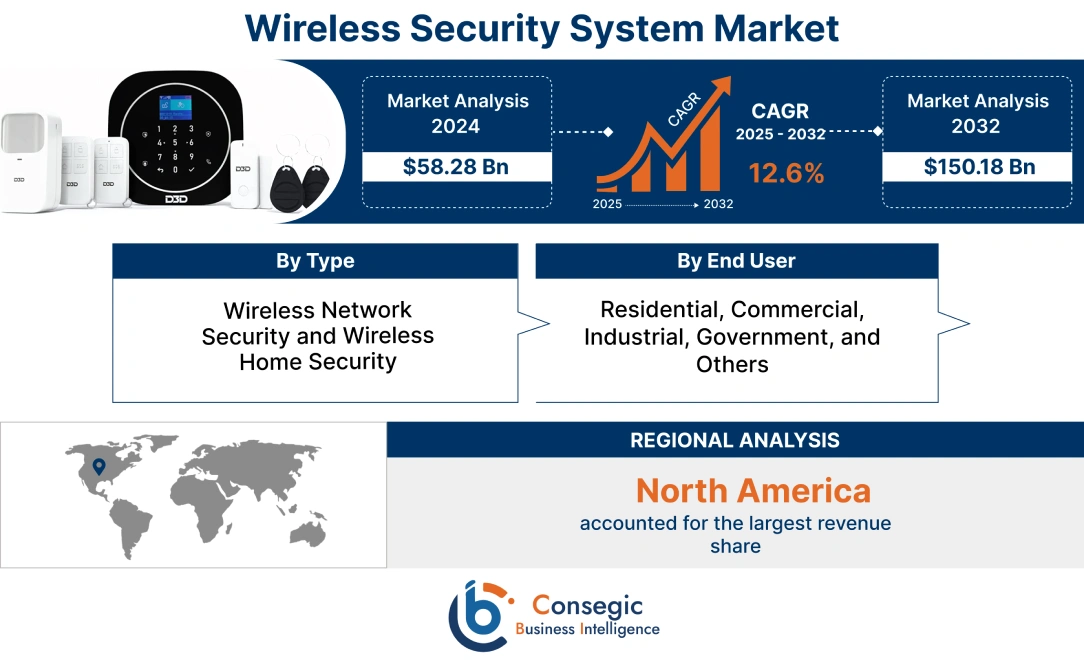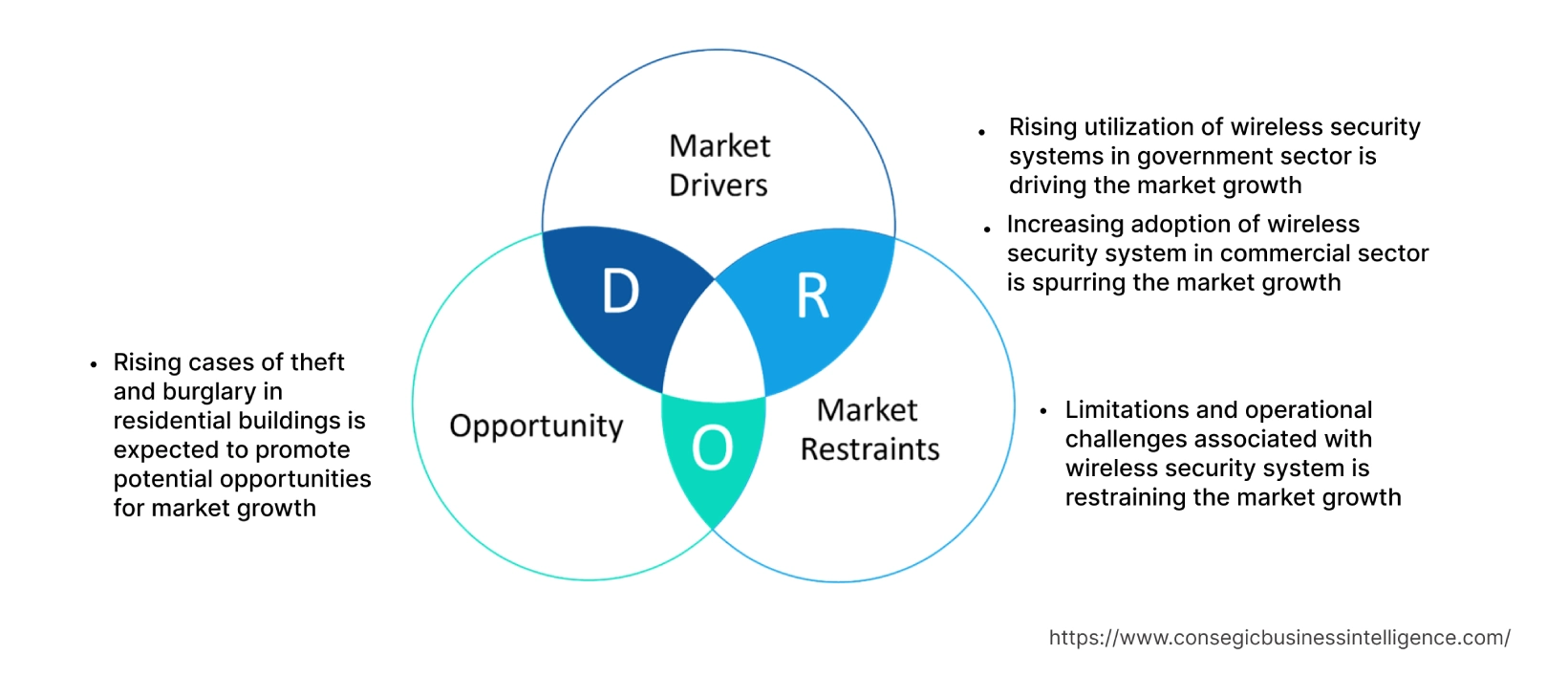- Summary
- Table Of Content
- Methodology
Wireless Security System Market Introduction :
Wireless Security System Market size is estimated to reach over USD 150.18 Billion by 2032 from a value of USD 58.28 Billion in 2024, growing at a CAGR of 12.6% from 2025 to 2032.
Wireless Security System Market Definition & Overview:
Wireless security systems consist of a network of integrated electronic devices that function together to protect property against unauthorized entries, thefts, and intruders. Moreover, they also play a crucial role in protecting networks and devices connected in a wireless environment including Wi-Fi networks. Additionally, they offer several benefits including higher scalability, flexibility, enhanced security, ease of accessibility, and others. Their aforementioned benefits are key determinants for increasing its utilization in residential, commercial, government, and industrial sectors among others.
Wireless Security System Market Insights :
Key Drivers :
Rising utilization in government sector
Wireless security systems, particularly wireless network security, is primarily employed in government organizations to ensure that devices, data, and login credentials remain secure and confidential. Moreover, they are capable of identifying potentially vulnerable connections and protecting common wireless technologies deployed in government organizations to prevent data breaches or cybercrimes. Their above mentioned benefits are key determinants for driving its utilization in the government sector.
Factors including the rising number of data breaches, and cyberattacks among others, coupled with increasing requirement for scalable data security solutions are among the key determinants driving the adoption of the security systems in the government sector.
For instance, in September 2021, Baltimore Police Department of United States adopted Cisco's network security solution with the aim of securing and protecting the Baltimore Police Department's network. Baltimore Police Department integrated Cisco secure malware analytics and Cisco secure network analytics into its network to obtain advanced security analytics, real-time network visibility, and protection against malware and cyberattacks. Additionally, in July 2022, Shanghai Municipal Police, a Chinese government organization, witnessed a huge data breach leaking the personal information of one billion Chinese residents from the Shanghai police database stored in the cloud. Analysis of market trends concludes that the rising incidence of data breaches and cyberattacks in government organizations is driving the necessity of the systems for the protection of crucial and confidential data stored in wireless networks, in turn proliferating the wireless security system market demand.
Increasing adoption in commercial sector
Wireless security systems are deployed in the commercial sector including banking & financial institutions, offices, retail stores, educational institutes, and hospitals, among others for improved security. Additionally, they play a vital role in improving property security while warning individuals regarding any unauthorized entry within the commercial property. Their above are increasing its adoption in the commercial sector.
Factors including the growing pace of urbanization, rising development of commercial buildings, and increasing requirement for enhanced security solutions in commercial spaces are primary aspects driving adoption of the security system.
According to CoreLogic Inc., the overall sales of commercial properties including offices, hotel, retail, and others inclined by 16% during the second quarter of 2021 in comparison to 2019. Analysis of market trends concludes that the expansion of commercial sector is driving the deployment of the security systems in commercial buildings to offer enhanced security and notify the access of unauthorized individuals into commercial spaces, thereby, driving the wireless security system market demand.
Key Restraints :
Limitations and operational challenges
Wireless security systems are often associated with certain limitations and operational challenges, which is a key factor constraining market proliferation as per analysis of the market trends.
For instance, they are highly prone to inference and disruption of signals, which may hamper the system's performance or generate false alarms. Moreover, they are relatively expensive in comparison to wired systems and require an initial investment, which includes equipment costs including smart cameras, sensors, remote key panels, and others along with additional installation costs.
Additionally, they are susceptible to password vulnerabilities as all the components connected wirelessly require password-based authentication. Hence, the aforementioned limitations and operational challenges associated with them are restraining the expansion of the market.
Future Opportunities :
Rising cases of theft and burglary in residential buildings
The rising incidence of theft and burglary in residential buildings are expected to present potential opportunities for the expansion of the wireless security system market. Wireless security systems are often installed in residential buildings to protect the residential property against burglary, thefts, or unauthorized intruders. Additionally, their integration in residential buildings offers several benefits including reduced risk of theft and robbery, greater security, and the ability to control multiple doors remotely. Their above benefits are further increasing its integration in residential buildings.
Factors including growing residential construction, rising prevalence of theft and burglary, and increasing the requirement of improved security in residential buildings are expected to promote lucrative growth aspects for the market.
For instance, according to Forbes, more than one Billion cases of home burglaries occur on average in the United States every year. Further, according to the Federal Bureau of Investigation of United States, residential property account for around 61% of all burglaries in the U.S. Analysis of market trends concludes that the rising occurrence of theft and burglary in residential buildings is fostering the integration of the security systems, which in turn is emerging as one of many wireless security system market opportunities that will drive market expansion during the forecast period.
Wireless Security System Market Report Insights :
| Report Attributes | Report Details |
| Study Timeline | 2019-2032 |
| Market Size in 2032 | USD 150.18 Billion |
| CAGR (2025-2032) | 12.6% |
| By Type | Wireless Network Security and Wireless Home Security |
| By End User | Residential, Commercial, Industrial, Government, and Others |
| By Region | North America, Europe, Asia-Pacific, Latin America, and Middle East & Africa |
| Key Players | ASSA ABLOY, Bosch Security Systems LLC, ADT, Cisco Systems Inc., Broadcom, Honeywell International Inc., ZTE Corporation, ALE International, Juniper Networks, Hewlett Packard Enterprise Development LP |
Wireless Security System Market Segmental Analysis :
Based on the Type :
Based on the type, the market is bifurcated into wireless network security and wireless home security. In 2024, the wireless network security segment accounted for the highest wireless security system market share. Wireless network security mainly protects a wireless network from malicious and unauthorized access attempts or cyberattacks. Wireless network security is often delivered through utilization of wireless devices that typically encrypts and secures all wireless communication. Wireless network security is primarily utilized in governmental and commercial organizations for protection of wireless networks from cyberattacks, confidential data breaches, and malicious activities among others.
For instance, more than 100,000 login details associated with Australian government agencies were leaked in a massive data breach in January 2023. Analysis of wireless security system market trends concludes that the rising incidence of data breaches and cyberattacks in government organizations is driving the necessity of wireless network security for the protection of crucial and confidential data stored in wireless networks, in turn contributing to the expansion of the market.
The wireless home security segment is anticipated to register significant CAGR growth during the forecast period. Wireless home security systems primarily operates through existing internet signal for creating a seamless operation of the entire home defense from thefts, burglary, or unauthorized intruders entry. Moreover, wireless home security systems offer several benefits including remote control, programmable features, smartphone alerts or notifications, and enhanced safety. The above benefits of wireless home security systems are key determinants for driving its integration in residential buildings among others.
For instance, according to the State of Nevada, U.S., the new residential building permits in Nevada reached 23,406 units in 2021, witnessing a rise of nearly 19% as compared to 19,716 units in 2020. Assessment of market trends indicates that the rise in residential construction is further fostering the demand for wireless home security systems to offer enhanced home security and protection, in turn driving the wireless security system market growth during the forecast period.
Based on the End User :
Based on the end user, the market is segregated into residential, commercial, industrial, government, and others. In 2024, the commercial segment accounted for the highest wireless security system market share of 32.4% in the market. Factors including the increasing pace of urbanization, rising development of commercial buildings, and growing demand for enhanced security solutions in commercial spaces are among the key prospects fostering the proliferation of the commercial segment.
According to the UK Office for National Statistics, the new private commercial construction orders in the United Kingdom were valued at USD 4,295.1 million during the fourth quarter of 2022, witnessing an increase of 5.5% in comparison to the fourth quarter of 2019. Examination of market trends concludes that the rise in commercial construction is driving the adoption of wireless security systems in commercial buildings to offer enhanced security and notify the access of unauthorized individuals into commercial buildings, in turn driving the proliferation of the market.
Residential segment is expected to witness fastest CAGR growth during the forecast period. The expansion of the residential segment is attributed to several factors including the growing residential construction, rising prevalence of theft and burglary, and increasing requirement of improved security in residential buildings among others.
According to CoreLogic Inc., the sales of multi-family residential property in the United States witnessed a substantial increase of 26% during the second quarter of 2021 in comparison to 2019. Assessment of market trends indicates that the expansion of residential sector is driving the utilization of wireless security systems for protection of residential buildings against theft, burglary, and unauthorized intruders. The above factors are projected to boost wireless security system market growth during the forecast period.
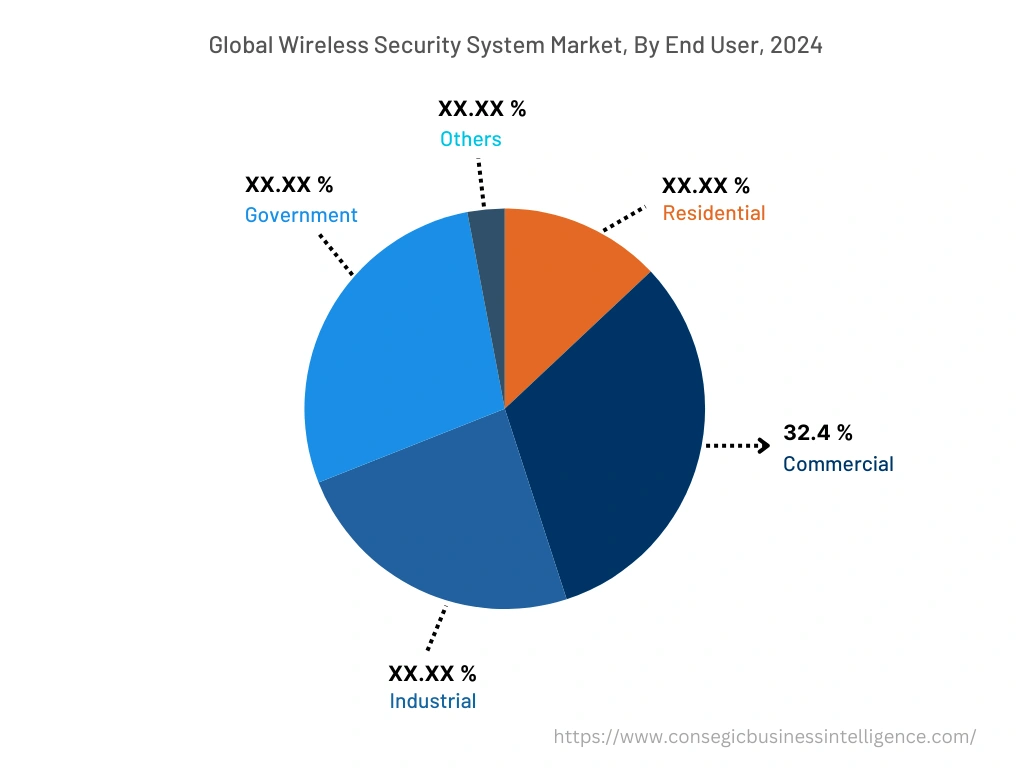
Based on the Region :
The regional segment includes North America, Europe, Asia Pacific, Middle East and Africa, and Latin America.
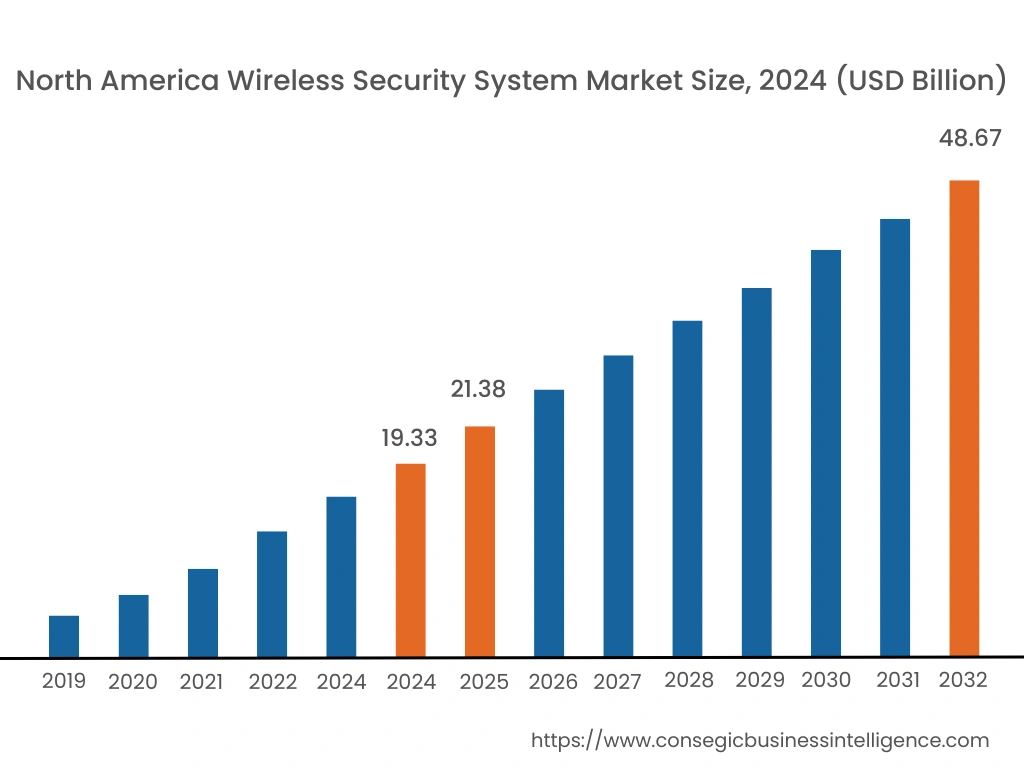
North America accounted for the largest revenue share of USD 19.33 Billion in 2024 and is expected to reach USD 48.67 Billion by 2032, registering a CAGR of 12.20% during the forecast period. In addition, in the region, the U.S. accounted for the maximum revenue share of 59.45% in the same year. The wireless security system market analysis concluded that the adoption of the systems in North America is primarily driven by multiple factors including its rising utilization in residential and commercial sectors including offices, educational institutes, and financial institutions among others. The utilization of security systems in commercial buildings for effective monitoring of individuals' access to a commercial property and for alerting the entry of intruders to provide optimum safety has been a prevalent factor for proliferation of the market in the region.
Moreover, the rising occurrence of burglaries and robberies in the commercial sectors involving financial institutions is a vital factor fostering the market demand in the region. For instance, according to the 2021 Bank Crime Statistics Report, approximately 234 cases of burglaries and 1,724 cases of robberies were recorded in financial institutions including commercial banks, credit unions, mutual saving banks, and others in the United States in 2021. Hence, the aforementioned factors are anticipated to stimulate the demand for systems in North America during the forecast period.
Asia-Pacific is expected to register fastest CAGR growth of 13.0% during the forecast period. The rapid pace of urbanization, industrialization, and development is promoting lucrative opportunities for market expansion in the region. The wireless security system market analysis concluded that the rising government initiatives for development of smart cities in the Asia-Pacific region are contributing to the market growth. For instance, the government of China launched various initiatives including National New-type Urbanization Plan, China's 14th five-year Development Plan (2021 to 2025), and smart cities projects that aims at facilitating the development of smart homes in the country. In addition, multiple factors including the rise in commercial and industrial construction and increasing need for enhanced home security solutions are further projected to drive the demand for the market in the Asia-Pacific region during the forecast period.
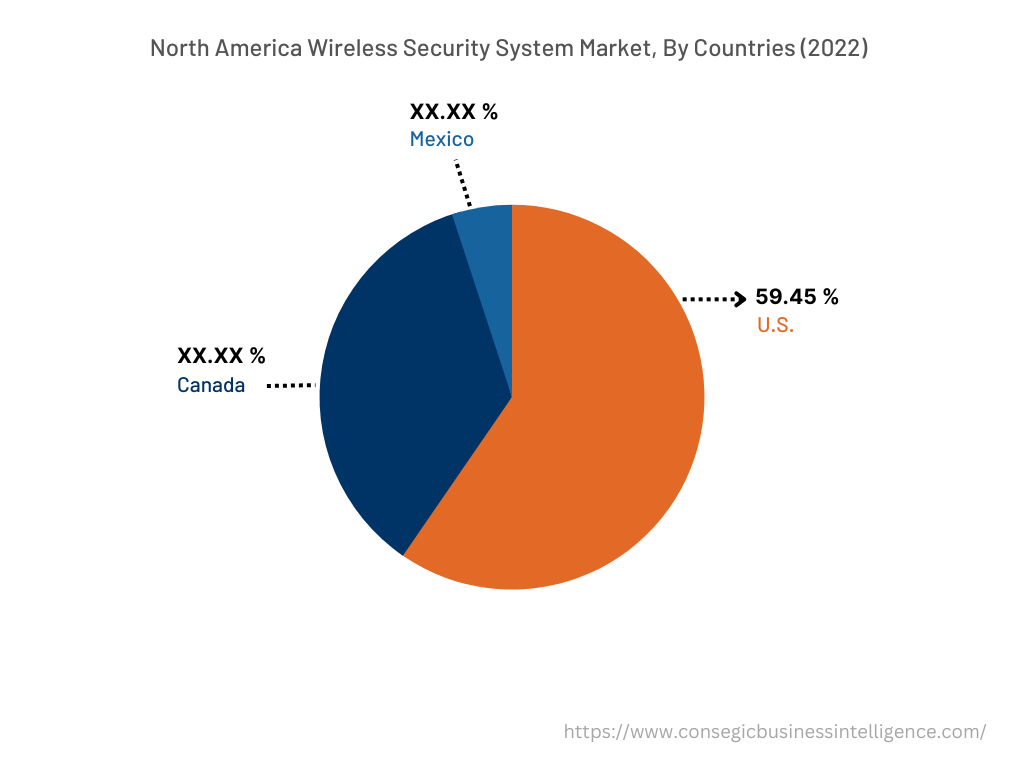
Top Key Players & Market Share Insights:
The wireless security system market is highly competitive with major players providing porducts to the national and international markets. The major companies operating in wireless security system industry are adopting several strategies in research and development (R&D), product innovation, and application launches to hold a strong position in wireless security system market. Key players in the wireless security system market include-
- ASSA ABLOY
- Bosch Security Systems LLC
- ALE International
- Juniper Networks
- Hewlett Packard Enterprise Development LP
- ADT
- Cisco Systems Inc.
- Broadcom
- Honeywell International Inc.
- ZTE Corporation
Recent Industry Developments :
- In June 2023, ASSA ABLOY partnered with Verkada Inc. for expansion of its network of wireless lock integrations for enhanced security. The partnership enables an integration of with the Aperio line-up of wireless locks with extended capabilities of Verkada's line-up of door controllers.
- In September 2020, Honeywell International Inc. introduced its Pro-Watch Integrated Security Suite that is capable of providing a complete visibility of all connected systems for monitoring and managing security events from a single view.
Key Questions Answered in the Report
What is wireless security system? +
Wireless security systems consist of a network of integrated electronic devices that function together to protect property against unauthorized entries, thefts, and intruders. Moreover, wireless security systems also play a crucial role in protecting networks and devices connected in a wireless environment including Wi-Fi networks.
What specific segmentation details are covered in the wireless security system report, and how is the dominating segment impacting the market growth? +
By type segment has witnessed wireless network security as the dominating segment in the year 2024, owing to its increasing utilization in governmental and commercial sectors, among others.
What specific segmentation details are covered in the wireless security system market report, and how is the fastest segment anticipated to impact the market growth? +
By end user segment has witnessed residential as the fastest-growing segment during the forecast period due to rising residential construction and increasing integration of advanced home security solutions in residential buildings.
Which region/country is anticipated to witness the highest CAGR during the forecast period, 2025-2032? +
Asia-Pacific is anticipated to register fastest CAGR growth during the forecast period due to rapid pace of industrialization and rising building & construction projects in the region.
